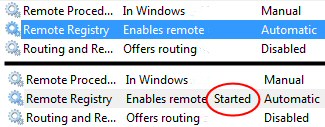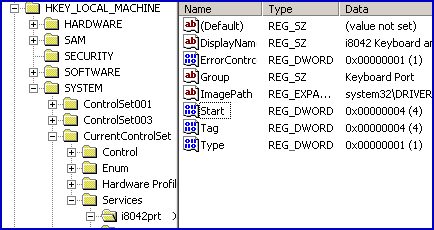How to Enable the Windows 7 Remote Registry Service 
This page explains how to enable the Windows 7 Remote Registry service. The benefit is that using Regedit you can ‘Connect Network Registry’ and repair a stricken machine.
If this service has not started, don’t worry, I have scripts which will start remote registry on any machine on your network (firewall permitting).
Topics for Enable Remote Registry in Windows 7
- ‘Connect Network Registry’ Strategy
- Psycho and the Keyboard
- Windows 8 Registry Cleaners
- Remote Registry – Starting the Service
- Programs and Utilities that Depend on Remote Registry
- Summary of Remote Registry Service
♦
Defining the Remote Registry Problem
When you launch regedit and try to ‘Connect Network Registry’, you get an error message saying ‘Object (Computer) cannot be found’. This is despite the fact that you can ping the machine.
The situation is that Microsoft implement Remote Registry as a service, thus you control it just as you would enable the Spooler or SNMP service.
Windows 7 Enable Remote Registry Manually
Begin with the easiest method, which is to start the Remote Registry service manually. Incidentally, knowledge gained here will help you master the scripting methods to enable a remote registry connection.
To start the Remote Registry services manually
- Click on the Start Button, in the Start Search dialog box, type: ‘Services’.
- Scroll down the list of services until you come to those beginning with ‘R’; right-click Remote Registry, and select Start from the short-cut menu.
- Alternatively, you can double click the service and check the settings, see screenshot below.
Guy Recommends: SolarWinds Free Wake-On-LAN Utility
Encouraging computers to sleep when they’re not in use is a great idea – until you are away from your desk and need a file on that remote sleeping machine!
WOL also has business uses for example, rousing machines so that they can have update patches applied. My real reason for recommending you download this free tool is because it’s so much fun sending those ‘Magic Packets’. Give WOL a try – it’s free.
Download your free copy of SolarWinds Wake-On-LAN
To Enable Remote Registry Services Using PowerShell
The very first time you try ‘Remoting’ with PowerShell it’s difficult to get the two machines to see each other. Your best chance of success is to understand the sequence, then master each step before going onto the next.
WinRm – Pre-requisite for Remote PowerShell
Stage One – Enable WinRm for PowerShell Remoting
Even with all the components installed correctly, (PowerShell v 2.0 CTP3, .Net Framework and WinRm), remoting still won’t work until you run this cmdlet from within PowerShell (not DOS):
Enable-PSRemoting
Note 1: You need remoting setup on both computers.
Note 2: That unlike PSSession commands, this function only has one ‘S’ PSRemoting.
Stage Two – Create a Session Between the Machines
New-PSSession -computerName testMachine2
# Or simply:
Enter-PSSession -computer testMachine2
Troubleshooting
If this PowerShell command does not work, then back to basics. Start with ping testMachine2 (or whatever your computer is called). Despite what experts say, I disable firewalls for the duration of troubleshooting, it just gives me peace of mind that a blocked port is not the problem. Next check permissions. Log on as someone with administrative permission on both machines. Still no joy? Then focus on the WinRM service, are you sure it’s functioning correctly? And you do have PowerShell v 2.0 or later – don’t you?
Stage Three – Start the Remote Registry Service
# Check Status (and make sure you have the correct name).
get-Service RemoteRegistry
# The business part of the script
start-Service RemoteRegistry
Note 1: For scripting purposes, RemoteRegistry is all one word, even though it’s display name has a space:
Remote Registry.
SolarWinds Firewall Browser 
Here is an utility where you can review firewall settings such as access control lists (ACL), or troubleshoot problems with network address translation (NAT).
Other reasons to download this SolarWinds Firewall Browser include managing requests to change your firewall settings, testing firewall rules before you go live, and querying settings with the browser’s powerful search options.
Guy recommends that you download a copy of the SolarWinds free Firewall Browser.
To Start the Remote Registry Services Using VBScript
- Copy and paste the script below into notepad.
- Save the file with a .vbs extension e.g. RemoteRegistry.vbs.
- Double click the script, then enter the names of the server.
- Wait for a confirmation message.
‘ RemoteRegistry.vbs
‘ Sample script to Start Remote Registry on strComputer
‘ www.computerperformance.co.uk/
‘ Created by Guy Thomas February 2007
‘ Version 2.4
‘ ——————————————————-‘
Option Explicit
Dim objWMIService, objItem, objService
Dim colListOfServices, strComputer, strService, strInput
strInput = False
‘ Creates the Input Message Box
Do
strComputer = InputBox("Which Machine? "_
," Remote Machine", strComputer)
If strComputer <> "" Then strInput = True
Loop Until strInput = True
‘ NB Spelling of RemoteRegistry (No space).
strService = " ‘RemoteRegistry’ "
Set objWMIService = GetObject("winmgmts:" _
& "{impersonationLevel=impersonate}!\\" _
& strComputer & "\root\cimv2")
Set colListOfServices = objWMIService.ExecQuery _
("Select * from Win32_Service Where Name ="_
& strService & " ")
For Each objService in colListOfServices
WSCript.Sleep 1500
objService.StartService()
Next
WScript.Echo "Started " & strService & " on " & strComputer
WScript.Quit
‘ End of Example WMI script to Start / Stop services
Learning Points
Note 1: The name for this service has no space, moreover you need to enclose " ‘ RemoteRegistry ‘ " in both double and single quotes.
Note 2: It may occur to you that you could amend the strService, and thus start other services such as, System Attendant on an Exchange server.
 Guy Recommends: The Free Config Generator
Guy Recommends: The Free Config Generator
SolarWinds’ Config Generator is a free tool, which puts you in charge of controlling changes to network routers and other SNMP devices. Boost your network performance by activating network device features you’ve already paid for.
Guy says that for newbies the biggest benefit of this free tool is that it will provide the impetus for you to learn more about configuring the SNMP service with its ‘Traps’ and ‘Communities’. Try Config Generator now – it’s free!
Download your free copy of Config Generator
Case Study for Enabling Remote Registry
Psycho and the Keyboard
Here is a scenario for remote registry editing. On a training course I had a Psycho user. He was nothing but trouble, arrived late, spilt coffee over his monitor and worse still, would not listen to instructions. As usual, I showed the delegates the AutoAdminLogon =1 setting. My purpose was to save them typing a difficult password, after each reboot required by the notes.
The problem started when for some bizarre reason, Psycho decided to disable his keyboard and mouse. After Psycho rebooted his machine, AutoAdminLogon, by design, let his account logon without entering a username and password. His machine was useless; you could use neither the keyboard nor the mouse. The full horror became apparent when we tried to use Last Known Good to revert to the previous setting. AutoAdminLogon had overwritten the old control set. His machine was as they say, ‘stuffed’ – a condition I would have liked to extend to Psycho.
Well, you’ve probably guessed the happy outcome, I logged on as administrator at another machine, launched regedit, and then selected ‘Connect Remote Registry’. Once I opened Psycho’s registry I drilled down to the keyboard and mouse setting using this path: HKLM, System, CurrentControlSet Services, i8042prt. Then it was a trivial task to change a REG_DWORD called Start from 4 to 1.
I don’t wish to spoil a good story, but I have to point out that the above rescue scenario was on a Windows Server 2003 machine. On Windows 7 the keyboard and mouse driver is configured differently, consequently it no longer supports the above registry settings. ‘No worries’, as my Australian cousin says, the remote registry principle is sound. No doubt Psycho will find a new way of breaking your machine, and it is quite likely that remote registry editing will be the only way to recover from his stupidity.
Recommended: Solarwinds’ Permissions Analyzer – Free Active Directory Tool
I like the Permissions Monitor because it enables me to see WHO has permissions to do WHAT at a glance. When you launch this tool it analyzes a users effective NTFS permissions for a specific file or folder, and takes into account network share access, then displays the results in a nifty desktop dashboard!
Think of all the frustration that this free SolarWinds utility saves when you are troubleshooting authorization problems for user’s access to a resource. Give this permissions monitor a try – it’s free!
Download SolarWinds’ Free Permissions Analyser – Active Directory Tool
Programs and Utilities that Depend on Remote Registry
In addition to its obvious registry function, there other services and utilities that rely on the Remote Registry service: DCDiag, NetDiag and Terminal Services Licensing.
(There is a rumour that Remote Desktop requires the Remote Registry service, but on my machine I was able open a session with an XP Remote desktop, even though Remote Registry was disabled on the target machine. Do email me if you can shed any light on this rumour, or indeed you know of other services that require Remote Registry.)
Summary of Enable Remote Registry Service.
Practice enabling Windows 7 Remote Registry; prepare for that day when you are going to need access to the registry of a sickly machine on your network. It’s easy to forget that the Remote Registry service may not be started on the target machine. For that scenario, I have instruction on how use PowerShell to restart the Remote Registry on another network machine
If you like this page then please share it with your friends







